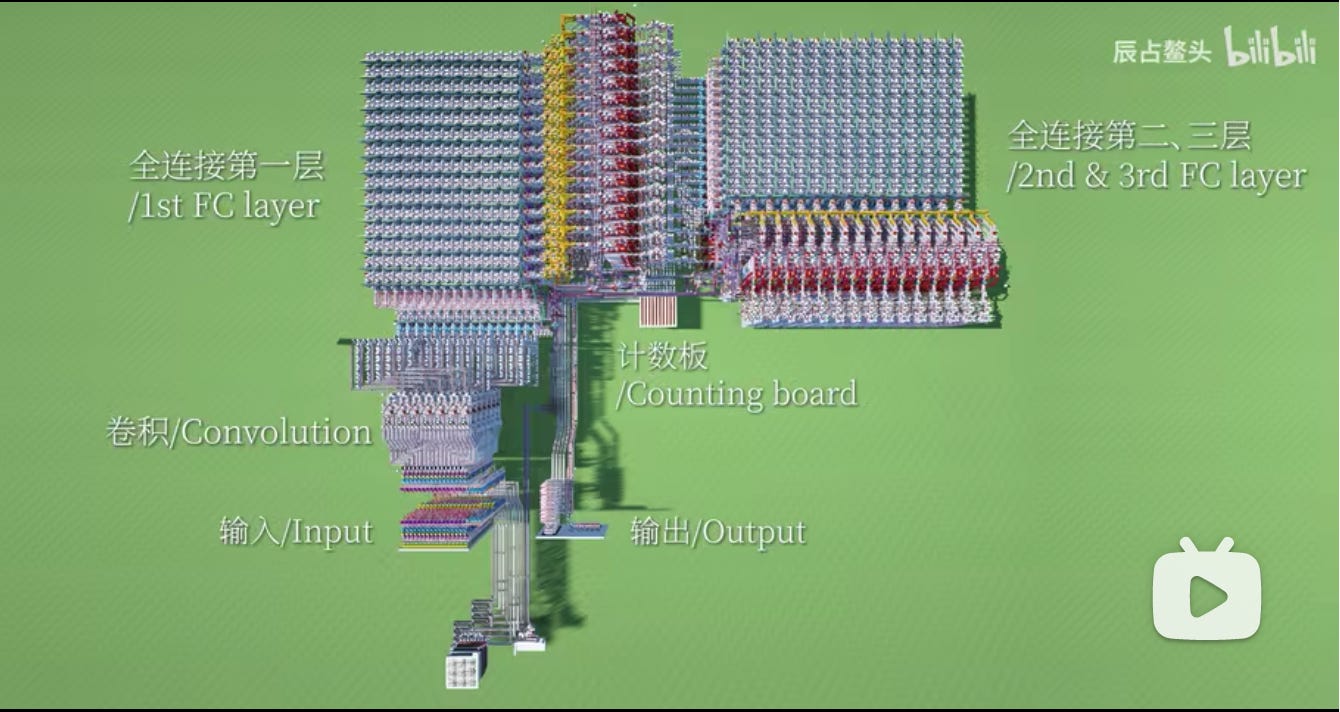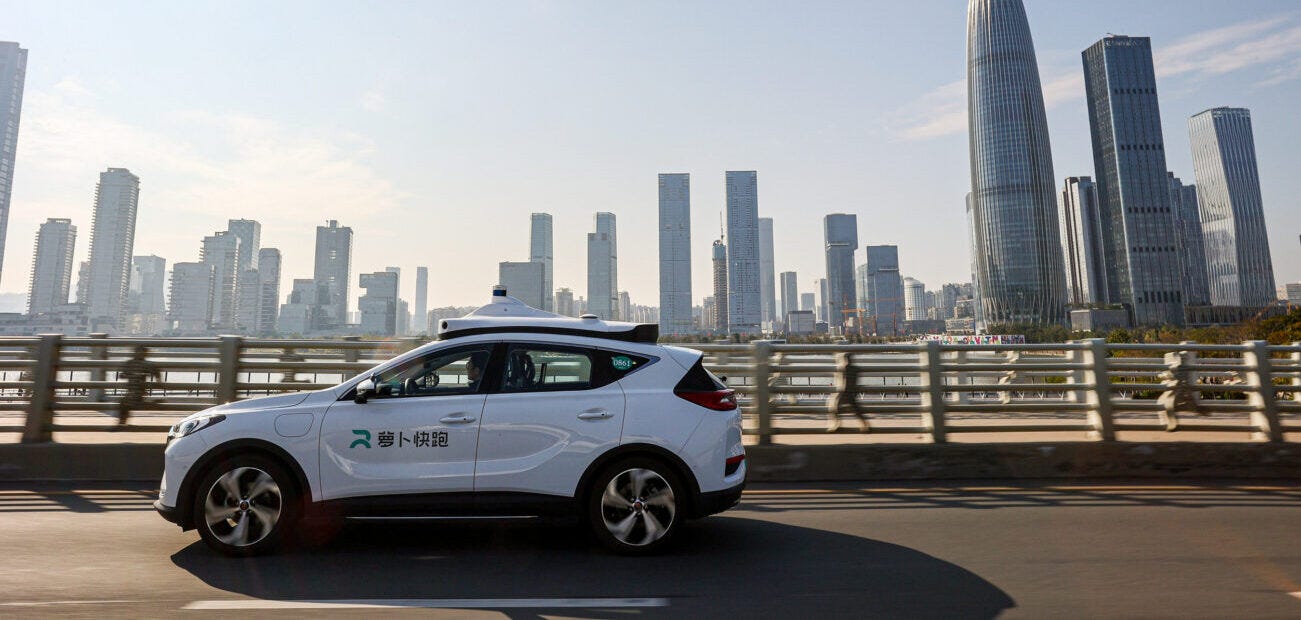Meet World's 1st Redstonic Neural Network in Minecraft; Shenzhen Holds Self-Driving Car Drivers Responsible for Crashes; AI Brings Back Decades-Old Concert
Weekly China AI News from July 4 to July 10
News of the Week
Bilibili Creators Build World’s 1st Neural Network in Minecraft
What’s new: While most artificial neural networks are built in coding, a team of five Chinese recently implemented a neural network in the sandbox video game Minecraft - the No.1 most played popular game - using a type of in-game element named redstones. They demonstrated the network in a video uploaded on Chinese YouTube-like Bilibili 10 days ago that quickly garnered over 1 million views and gained eyeballs from Yann LeCun, Meta Chief AI Scientist and Turing Award recipient, who praised the work on Twitter as “very meta”.
Principles: Boasted as the world’s first redstonic neural network, the network uses LeNet, a CNN architecture created by LeCun in 1989, as the backbone and can recognize 15×15 handwritten digits with up to 80% accuracy. The input device includes a single-pulse pressure plate tablet and a 15×15 coordinate screen. The input figure data then passed through a 3×3 convolution layer with ReLU and three fully-connected layers with tanh.
The creators said they used stochastic computing to realize the network, making it much simpler in design and layout compared to traditional full-precision computing. They pre-trained the neural network in PyTorch and constructed the network in Minecraft, The recognition time is 5 minutes per figure theoretically. However, limited by the computational capacity of Minecraft, the real running time exceeds 20 minutes.
Video: You can watch the first video 【Minecraft】世界首个纯红石神经网络! and the second deep dive video【Minecraft】红石卷积神经网络——原理. The code is available at GitHub StochasticNet.
New Shenzhen Regulation Holds Self-Driving Car Drivers for Accident Liability
What’s new: Shenzhen last week approved a regulation that stipulates drivers of self-driving cars will be held responsible for accidents.
As a first-of-its-kind regulation in China (and maybe in the world) that clarifies liabilities for cars with self-driving capabilities, the Regulations of Shenzhen Special Economic Zone on the Management of Intelligent Connected Vehicles will go into effect on August 1, 2022. Intelligent Connected vehicles are referred as to self-driving vehicles that are operated by an automated system. Below are noteworthy highlights.
Paired with drivers: The new regulation requires vehicles with conditional or high-level autonomous driving - comparable to L3 and L4 in the SAE Levels of Driving Automation - to be paired with drivers behind the wheel and an associated manual driving mode. Fully autonomous vehicles are allowed to remove drivers and manual driving systems, but can only run in designated areas.
Responsibilities: The driver of a self-driving car - with conditional or high-level automation - will be held responsible for damages resulting from the accident if they are at fault, according to the new regulation. If the accident is caused by the vehicle due to systematic failures, the driver, the owner, or the operator of the vehicle can seek compensation from the car manufacturer and seller.
The owner and the operator of fully autonomous vehicles and are liable for a car crash, on the other hand.
Communications with other road users: Manufacturers of self-driving cars must equip the vehicle with an external device that can indicate its autonomous driving mode.
Chinese TikTok Restores Decades-Old Concert Using AI
What’s new: An AI-enhanced video of a concert performed by prominent Hong Kong rock band Beyond three decades ago was streamed on TikTok’s Chinese counterpart Douyin last week, garnering over 140 million viewers to watch.
Who’s Beyond? Beyond was a Hong Kong rock band formed in 1983 and quickly became a household name in East Asia through the 1980s-90s, led by Wong Ka Kui. The concert, Beyond Live 1991 Life Contact Concert, was a concert held by Beyond at the Hung Hom Stadium in Hong Kong in September 1991, also the most-played one.
Technical details: Researchers from Volcano Engine, the enterprise tech unit of TikTok’s parent company ByteDance, refreshed the decade-old video by improving its horizontal resolution from 540p to 4K, a 16-times upgrade. They also employed:
Multiframe deinterlacing to remove the complex artifacts in early interlaced videos;
Adaptive portrait augmentation to restore facial details of Wong like hair strands and silhouette;
Color brightness enhancement to rebalance overexposure and darkened scenes;
Audio denoising, audio superresolution, and loudness normalization to improve audio quality.
Papers & Projects
CHEF: A Pilot Chinese Dataset for Evidence-Based Fact-Checking
Researchers from Tsinghua University, the University of Cambridge, and the University of Illinois at Chicago proposed CHEF, the first CHinese Evidence-based Fact-checking dataset of 10K real-world claims. The dataset covers multiple domains, ranging from politics to public health, and provides annotated evidence retrieved from the Internet. Further, we develop established baselines and a novel approach that is able to model the evidence retrieval as a latent variable, allowing jointly training with the veracity prediction model in an end-to-end fashion. Extensive experiments show that CHEF will provide a challenging testbed for the development of fact-checking systems designed to retrieve and reason over non-English claims.
PSP: Million-level Protein Sequence Dataset for Protein Structure Prediction
Researchers from Changping Laboratory, Peking University, Huawei, and others presented the first million-level protein structure prediction dataset with high coverage and diversity, named PSP. This dataset consists of 570k true structure sequences (10TB) and 745k complementary distillation sequences (15TB). They provide in addition the benchmark training procedure for the SOTA protein structure prediction model on this dataset. They validate the utility of this dataset for training by participating CAMEO contest in which the model won first place.
Secretflow: A Unified Framework for Privacy-Preserving Data Analysis and Machine Learning
Alibaba’s fintech arm Ant Group open sourced SecretFlow, a unified framework for privacy-preserving data intelligence and machine learning. The framework provides
An abstract device layer consists of plain devices and secret devices which encapsulate various cryptographic protocols.
A device flow layer modeling higher algorithms as device object flow and DAG.
An algorithm layer to do data analysis and machine learning with horizontal or vertical partitioned data.
A workflow layer that seamlessly integrates data processing, model training, and hyperparameter tuning.
Rising Startups
DMAI, a cognitive AI company, has raised RMB500 million ($75 million) in its Series B financing round. Founded in 2017 by renowned computer vision luminary Song-Chun Zhu, the Guangzhou-based company develops cognitive AI assistants and platforms in the education and gaming industries.
MetaX, an integrated circuit design company specializing in GPU, has raised RMB1 billion ($150 million) in its Pre-B financing round. Founded in 2020, the Shanghai-based company develops high-performance GPU silicon for use in artificial intelligence, video and graphics rendering, and more.
Autowise.ai, an autonomous driving tech company, has raised RMB200 million ($30 million) in its Series B2 financing round. Founded in 2017 by former Didi Chuxing auto-driving chief Chao Huang, the Shanghai-based company develops autonomous sweepers and scrubbers for both indoor and outdoor cleaning.







